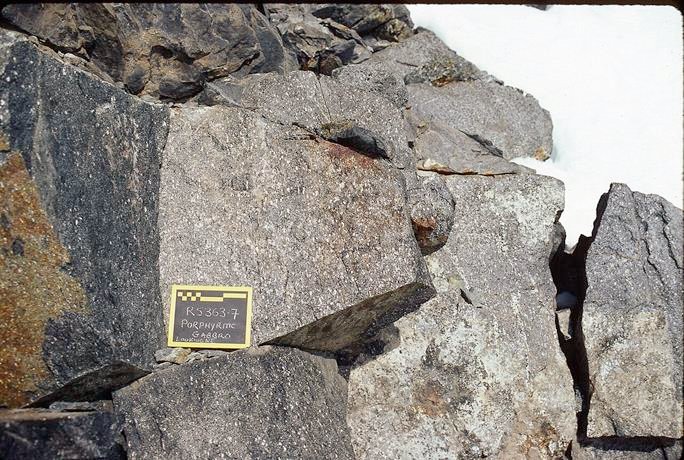Porphyritic gabbro has large, well-formed crystals of mostly calcic-plagioclase and sometimes augite, rarely olivine or other mafic minerals set in a finer-grained but phaneritic matrix.
The matrix mainly has plagioclase and augite with minor amounts of olivine, enstatite, diopside, alkali feldspar, hornblende, accessory, and other minerals.
The larger crystals are known as phenocrysts, while the finer-grained matrix is known as groundmass.
Remember, gabbro is a coarse-grained rock, equivalent to basalt, a volcanic rock. Thus, its groundmass is coarse-grained or phaneritic since it cools slowly deep inside the Earth’s crust or in thick basalt lava flows.
In porphyritic gabbro, the plagioclase in groundmass and phenocrysts is usually labradorite to bytownite with more than 50 mol.% anorthite.
On the other hand, alkali feldspar and any quartz formed will occur in the groundmass, especially in interstitial spaces.
Lastly, porphyritic gabbro rocks are also known as gabbro porphyry. Porphyry is a non that describes rocks with two distinctive grain sizes, and porphyritic is an adjective.

How is porphyritic gabbro formed?
Most porphyritic volcanic rocks form from two-stage cooling histories that involve magma erupting or moving close to the Earth’s surface.
The first stage is a slower one deep inside the Earth’s crust. It favors crystal growth over nucleation. This forms large crystals or phenocrysts.
The second stage is faster cooling near or on the Earth’s surface. This fast cooling results in lots of nucleation and a fine-grained texture.
However, this isn’t how gabbro porphyry forms. This rock forms where cooling is slow, either in thick, insulated lava flow or plutons deep inside the Earth’s crust. The cooling rate is more or less constant.
It is likely that porphyritic gabbro formed crystallization outside the eutectic composition or if nucleation and crystal growth rates were different.
Eutectic refers to a homogenous mixture or composition with lower temperatures than individual mineral constituents.
Here is more on how each of these ways:
1. Crystallization outside eutectic composition
It is possible that the larger crystals or phenocrysts started crystallizing earlier outside the eutectic composition.
This can happen to minerals with higher melting points. For instance, augite, labradorite, or bytownite can begin crystallizing earlier.
Such minerals will grow unimpeded in the mostly liquid magma, creating well-formed, large crystals or phenocrysts.
When the melt reaches eutectic composition, it will crystalize, forming a finer but coarse-grained matrix.
Minerals formed at eutectic composition will not have the space to grow large crystals.
Thus, you will have a porphyritic gabbro with earlier-formed crystals and eutectic, fine-grained phaneritic groundmass
2. Different nucleation rates
The larger crystals or phenocrysts in gabbro porphyry didn’t necessarily form early. They could have formed at the same time or even later. Remember, grain size depends on the nucleation and crystal growth rates.
For instance, the large crystals in gabbro could nucleate slowly but grow faster, while groundmass nucleates more but grows slowly.
Such a scenario will allow the slow-nucleating, faster-growing mineral grains to grow large and minimally impeded.
Uses of porphyritic gabbro
These rocks are dense, hard, and durable. Some of the porphyritic gabbros include the construction and dimension stone industry.
When crushed, they are excellent roadstone and make railroad ballast, concrete, mortar, asphalt, etc. You can also use the gravel on unpaved walkways, patios, driveways, etc.
On the other hand, they make excellent dimensional stones marketed as black granite. For instance, cut and polished ones can make pavers, tiles, and countertops. You can also use them on windowsills.
More uses include making statues, memorials, monuments, curbing stones, etc.
Where are they found?
Porphyritic gabbros occur where other gabbroic rocks occur. These include the oceanic crust beneath sheeted dikes, in ophiolites, and layered igneous intrusions.
Ophiolites are an ancient oceanic crust and upper mantle that is exposed to the Earth’s surface.
What are gabbro rocks?
Gabbro rocks are coarse-grained, dark-colored rocks. They are of mafic composition, i.e., rich in iron and magnesium.
These rocks are basic or silica-poor with 45-52 wt.% silica. Also, they are poor in sodium and potassium oxides and higher in iron, calcium, and magnesium oxides.
Mineralogically, gabbro has mostly calcic plagioclase (labradorite to bytownite with > 50 mol.% anorthite) and augite. Also, they have a smaller amount of enstatite, olivine, hornblende, quartz, alkali feldspar, and rarely biotite.
Accessory minerals in gabbro include magnetite, ilmenite, sulfides, spinel, zircon, and chromite, among others.
